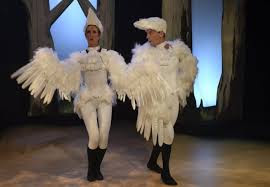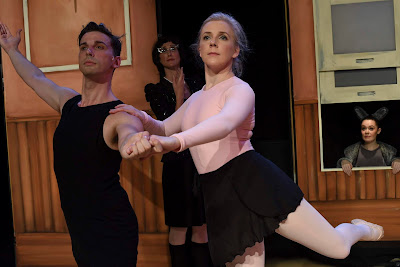 |
| Rebecca Hetherington as Josephine |
Choreographed by Tim Harbour – Designed by James Browne
Lighting designed by Emma Lockhart-Wilson
Presented by Monkey Baa Theatre Company
Canberra Theatre – 29th September 2018
Reviewed by Bill Stephens
The foyer was awash with littlies in favourite tutus
of all shapes and sizes. Some earnestly practiced on the barre and mirrors
thoughtfully provided by the presenters. Others, including quite a few boys
sans tutu, happily posed for photographs by doting grandmas and fathers in
front of a cut-out on which a couple of tutus had been pinned. Many clutched
copies of the little book by Jackie French and Bruce Whatley which inspired this
production. All could hardly contain their excitement at the prospect of seeing
their favourite Kangaroo brought to life on stage.
 |
| Chloe Dallimore - Amanda Laing - Hayden Rogers - Rebecca Hetherington (partly obscured) in "Josephine Wants To Dance" |
This rather magical little production, produced by
Monkey Bar Theatre, is aimed at children aged 4 – 9. Those children turned up
in their hundreds. None were disappointed, for as the lights went down audible
gasps of excitement could be heard around the auditorium as, one by one, four
large grey kangaroos took the stage, preened themselves, and the story of how
one of them, Josephine, saved the ballet company with her remarkable ability to
dance enpointe.
The production is beautifully mounted with a charming
story-book setting designed by James Browne. Elements of the set were
manipulated by the cast to represent indoor and outdoor scenes. Rebecca
Hetherington was a sprightly Josephine, who really could dance although no-one
believed that she could. All the other
characters were charmingly interpreted by Chloe Dallimore, Amanda Laing and
Hayden Rogers, all of whom changed costumes and characters so quickly and expertly
that it really felt like the cast was very much larger.
 |
| Chloe Dallimore and Hayden Rogers in "Josephine Wants To Dance" |
Jonathan Biggins directed with his customary attention
to detail and style. Phillip Scott created an enchanting score which included
cute songs with simple, concise lyrics to illuminate the story. Scott interwove
his dance music with references of famous ballet music to match the
authenticity of Tim Harbour’s affectionate choreography for the dance scenes.
You could hear a pin drop in the large auditorium as
the audience became caught up in the story, told in simple, but not simplistic,
language and scrupulously avoiding any hint of talking down to the young
audience or the time-wasting audience participation that blemishes so much
theatre in this genre.
 |
| Hayden Rogers -Amanda Laing - Chloe Dallimore and Rebecca Hetherington in "Josephine Wants To Dance" |
“Josephine Wants To Dance”, with its excellent
production values and quality performers adds further gloss to Monkey Baa
Theatre Company’s already stellar reputation for producing and touring quality
children’s theatre.











